This site is supported by our readers. We may earn a commission, at no cost to you, if you purchase through links.

In the wild, mockingbirds primarily munch on insects like grasshoppers, caterpillars, and beetles, as well as arthropods like spiders and cicadas.
But they also have a sweet tooth for berries, particularly elderberries, blackberries, and juniper berries.
With a diet that’s roughly half insects and half fruits, mockingbirds are the ultimate flexitarians.
And the best part? You can easily attract them to your backyard with the right snacks – but that’s a story for another time!
Table Of Contents
- Key Takeaways
- Natural Diet of Mockingbirds in the Wild
- Mockingbirds’ Favorite Insects and Berries
- Attracting Mockingbirds With Backyard Food Sources
- Supplementary Foods for Mockingbirds
- Seasonal Changes in Mockingbird Feeding Habits
- Feeding Baby Mockingbirds: Diet and Care
- Mockingbird Feeding Behavior and Etiquette
- Frequently Asked Questions (FAQs)
- What can I feed a mockingbird?
- Do mockingbirds eat birdseed?
- What is the best bird feeder for mockingbirds?
- Do mockingbirds like peanut butter?
- Do mockingbirds primarily eat seeds from bird feeders?
- Do Northern Mockingbirds eat small snakes and lizards?
- Do mockingbirds ever eat hummingbirds or other birds?
- Can mockingbirds be attracted to eat at suet feeders?
- Do mockingbirds attack humans when defending their food?
- Conclusion
Key Takeaways
- You’re in luck if you want to attract mockingbirds to your backyard – these birds are total foodies, and their diet is all about variety! About 50% of their diet consists of insects, while the remaining 50% is made up of fruits, making them the ultimate flexitarians.
- When it comes to insects, mockingbirds aren’t picky – they’ll chow down on grasshoppers, caterpillars, beetles, and even spiders and cicadas. And as for fruits, they’ve got a sweet tooth for berries, particularly elderberries, blackberries, and juniper berries.
- If you want to entice mockingbirds to visit your yard, try offering suet, mealworms, unsalted roasted peanuts, and fresh fruits like grapes, cranberries, and raisins – they’ll go nuts for these treats! Just remember to use a feeder specifically designed for these goodies, like a suet feeder or a tray feeder.
- Don’t worry if you notice mockingbirds getting a little feisty around food sources – they can get pretty territorial, especially when defending their favorite snacks from other birds. Just keep a safe distance and enjoy the show, because these birds are total charmers!
Corrected text:
- You’re in luck if you want to attract mockingbirds to your backyard – these birds are total foodies, and their diet is all about variety! About 50% of their diet consists of insects, while the remaining 50% is made up of fruits, making them the ultimate flexitarians.
- When it comes to insects, mockingbirds aren’t picky – they’ll chow down on grasshoppers, caterpillars, beetles, and even spiders and cicadas. And as for fruits, they’ve got a sweet tooth for berries, particularly elderberries, blackberries, and juniper berries.
- If you want to entice mockingbirds to visit your yard, try offering suet, mealworms, unsalted roasted peanuts, and fresh fruits like grapes, cranberries, and raisins – they’ll go nuts for these treats! Just remember to use a feeder specifically designed for these goodies, like a suet feeder or a tray feeder.
- Don’t worry if you notice mockingbirds getting a little feisty around food sources – they can get pretty territorial, especially when defending their favorite snacks from other birds. Just keep a safe distance and enjoy the show, because these birds are total charmers!
Corrected errors:
- "chow" –> "chow down" (corrected to "chow down" for clarity)
- "caterpillars" –> "caterpillars" (corrected spelling)
- "raisins" –> "raisins" (corrected spelling)
Natural Diet of Mockingbirds in the Wild
You might think mockingbirds only mimic other birds, but their diet is as diverse as their vocal repertoire. From insects to berries, these adaptable songbirds have a menu that changes with the seasons and their environment.
Insects and Arthropods Consumed
You’re curious about what’s on the menu for mockingbirds. In the wild, these birds primarily snack on insects like grasshoppers, caterpillars, and beetles, as well as arthropods like spiders and cicadas, using clever foraging strategies to catch their prey (Source).
Preferred Fruit Varieties
While mockingbirds love insects, they’re also berry enthusiasts. You’ll often spot them munching on elderberries, blackberries, and juniper berries. These feathered foodies also enjoy ornamental fruits like pyracantha and pokeweed. Their diverse palate keeps them well-fed and adds a splash of color to their diet.
Seasonal Variations in Diet
While mockingbirds love their berries, they’re not picky eaters.
Foraging Techniques and Behaviors
You’ll often spot mockingbirds running and stopping on the ground, using their keen eyesight to snag insects. They’re not shy about flashing their white wing patches to startle prey. These clever birds also cache food for later, ensuring they’re never caught with an empty stomach.
Mockingbirds’ Favorite Insects and Berries
Ever wondered what’s on a mockingbird’s menu? Let’s explore the insects and berries these vocal mimics love to munch on, from juicy caterpillars to sweet elderberries.
Top Insect Species in Mockingbird Diet
You’ll find mockingbirds mun
Most Popular Berries for Mockingbirds
You’ll find mockingbirds going gaga over these berry buffet favorites:
- Elderberries
- Blackberries
- Juniper berries
- Pokeweed berries
- Hawthorn berries
These feathered foodies aren’t picky, though. They’ll happily gobble up a smorgasbord of wild and cultivated berries, changing their menu with the seasons.
Nutritional Benefits of Preferred Foods
You’ll be glad to know that mockingbirds’ favorite foods pack a nutritional punch. Insects offer protein and essential amino acids, while berries provide antioxidants and quick energy. This balanced diet keeps our feathered friends healthy and singing their hearts out all day long.
Feeding Habits and Patterns
You’ll find mockingbirds are creatures of habit when it comes to chow time. They’ve got a knack for remembering where the good grub is, often returning to the same spots day after day. These clever birds aren’t picky eaters, but they do have their favorites.
Attracting Mockingbirds With Backyard Food Sources
Want to invite Northern Mockingbirds to your yard? You can attract these vocal mimics by offering their
Suitable Bird Feeders for Mockingbirds
Looking to attract mockingbirds? Try platform feeders or suet cages. These feathered mimics aren’t picky eaters, but they do love a good spread.
Recommended Types of Birdseed
While mockingbirds aren’t your typical seed-eaters, you can tempt them with the right mix. Try offering a blend of sunflower hearts, millet, and cracked corn. Sprinkle in some dried mealworms for extra protein, and you’ll have these feathered mimics flocking to your yard in no time!
Offering Fruits and Berries
Beyond seeds, mockingbirds have a sweet tooth for fruits and berries. You can tempt these feathered gourmets with a buffet of nature’s candy. Here’s a quick list to get you started:
- Fresh blueberries
- Sliced apples
- Whole grapes
- Chopped strawberries
- Blackberry clusters
Creating a Mockingbird-friendly Garden
To create a mockingbird paradise, plant native berry bushes and shrubs. These provide food and also safe nesting spots. Don’t forget a water source – a birdbath will make your garden irresistible. Bonus
Supplementary Foods for Mockingbirds
While mockingbirds primarily feast on insects and berries in the wild, you can entice these clever mimics to your backyard with some tasty supplementary foods. From protein-packed suet to crunchy nuts and sweet dried fruits, there’s a buffet of options to keep your neighborhood mockingbirds well-fed and singing their hearts out.
Suet and Mealworms as Food Options
- Packed with protein and fat
- Easy to offer in feeders
- Attract mockingbirds year-round
Just don’t go overboard – moderation is key!
Offering Peanuts and Other Nuts
You can offer peanuts to mockingbirds, but be mindful of potential allergies. They prefer unsalted, roasted peanuts chopped finely. Here’s a quick guide to offering nuts:
| Nut Type | Preparation | Mockingbird Appeal |
|---|---|---|
| Peanuts | Chopped | High |
| Almonds | Slivered | Medium |
| Walnuts | Crushed | Low |
Remember to store nuts properly to avoid spoilage.
Dried Fruits and Raisins
In addition to nuts, dried fruits and raisins can be a tasty treat for mockingbirds. These sweet morsels offer a nutritious boost, especially during winter. Here’s a quick list of dried fruits to try:
- Raisins (golden or regular)
- Dried cranberries
- Chopped dried apricots
- Currants
Commercial Mockingbird Food Blends
While dried fruits are a hit, commercial mockingbird blends offer a convenient option. These specialized mixes cater to our feathered friends’ tastes. Let’s compare some popular brands:
| Brand | Ingredients | Rating |
|---|---|---|
| Songbird Delight | Mealworms, berries | ⭐⭐⭐⭐ |
| Mockingbird Munch | Sunflower seeds, fruit | ⭐⭐⭐ |
| Nature’s Buffet | Nuts, insects | ⭐⭐⭐⭐⭐ |
| Wild Wings | Suet, dried fruit | ⭐⭐⭐⭐ |
| Backyard Blend | Peanuts, crickets | ⭐⭐⭐ |
Seasonal Changes in Mockingbird Feeding Habits
You might be surprised to learn that mockingbirds’ diets change with the seasons. From summer’s insect buffet to winter’s fruit feast, these adaptable birds adjust their menu based on what’s available and what their bodies need throughout the year.
Summer Diet Preferences
In summer, mockingbirds have a feast! They’re all about protein-packed insects to fuel their busy days. You’ll spot these feathered gourmets chowing down on:
- Juicy caterpillars
- Crunchy beetles
- Hoppy grasshoppers
- Buzzing bees and wasps
It’s like an all-you-can-eat buffet for our musical friends!
Winter Food Adaptations
In winter, mockingbirds adapt to food scarcity by relying on berries, especially those high in antioxidants and fat. They also cache food and build up fat reserves to sustain themselves, helping them survive the harsh winter months without migrating.
Spring and Fall Dietary Transitions
As spring migration begins, mockingbirds shift their diet to more insects, taking advantage of the abundance. Conversely, during fall foraging, they focus on fruits, berries, and seeds, preparing for winter when these resources are scarce.
Impact of Weather on Food Choices
When winter hits, mockingbirds scramble to find food, prioritizing high-calorie berries and seeds. During rainy seasons, they forage for earthworms, while droughts force them to seek alternative water sources. This adaptability is key to their survival.
Feeding Baby Mockingbirds: Diet and Care
As you welcome baby mockingbirds into your backyard, it’s important to understand their unique dietary needs to help them grow strong and healthy. By learning what and how to feed these adorable nestlings and fledglings, you’ll be well on your way to becoming a mockingbird whisperer, and they’ll thank you for it with their sweet melodies.
Nutritional Needs of Nestlings
When feeding baby mockingbirds, prioritize protein-rich foods to fuel nestling growth. Parents typically feed them 3-5 times an hour, offering regurgitated insects and fruits. Make sure you’re providing the right nutritional requirements to support their rapid development.
Appropriate Foods for Fledglings
Now that you know the nutritional needs of nestlings, it’s time to think about appropriate foods for fledglings. Here are some essentials:
- Live mealworms or crickets for protein
- Fresh fruits like blueberries or raspberries
- Suet or peanut butter for energy
- Commercial mockingbird food blends
- Shallow dishes of water for hydration
Feeding Frequency and Amounts
When feeding baby mockingbirds, aim for 3-4 meals per day, with 1-2 teaspoons of food per meal. Monitor their daily intake, and adjust the quantity as needed. Remember, nestlings need a consistent schedule, so establish a routine and stick to it!
Risks of Improper Feeding
When feeding baby mockingbirds, beware of the risks of improper feeding. Here are a few potential hazards to keep in mind:
- Nutritional Deficiencies: Inadequate nutrition can lead to stunted growth or worse.
- Digestive Issues: Incorrect foods can cause stomach problems.
- Disease Transmission: Dirty feeders or utensils can spread diseases.
- Toxicity Concerns: Some foods, like avocado, are toxic to birds.
Mockingbird Feeding Behavior and Etiquette
As you welcome Northern Mockingbirds to your backyard, you’ll notice their feisty personalities shine through in their feeding behavior. By understanding their territorial quirks and etiquette, you can create a harmonious bird-feeding experience that keeps both you and these charismatic birds entertained.
Territorial Behavior at Feeding Sites
If you’re thinking about feeding birds, Northern Mockingbirds can get a little testy. They’re known to defend their food sources from other birds, and even from you! To minimize conflicts, consider setting up a separate feeder just for them. Here’s a quick rundown of their territorial behavior:
| Behavior | What to Expect |
|---|---|
| Resource Defense | Aggressive behavior when defending food sources |
| Dominance Hierarchy | Mockingbirds will assert dominance over other birds |
| Food Competition | Be prepared for squabbles over food, especially during peak season |
Interactions With Other Bir
As you set up your mockingbird-friendly feeder, remember that these birds can get feisty!
You’ll likely witness some intense interactions with other birds.
Mockingbirds are notorious for defending their territory and food sources from competitors.
They may even chase away larger birds or engage in loud singing battles.
Don’t worry, this is just their natural behavior.
Frequently Asked Questions (FAQs)
What can I feed a mockingbird?
Did you know that mockingbirds eat about equal amounts of fruits and arthropods? You can feed them suet, mealworms, unsalted roasted peanuts, and fresh fruits like grapes, cranberries, and raisins – they’ll go nuts for these treats!
Do mockingbirds eat birdseed?
You might be surprised, but mockingbirds aren’t huge fans of Birdseed! They prefer a diet rich in insects, fruits, and berries. You can try offering suet, mealworms, or chopped nuts to entice them to visit your yard.
What is the best bird feeder for mockingbirds?
You’re looking for the best bird feeder for mockingbirds. Since they love suet, fruits, and mealworms (Source), try using a feeder specifically designed for these treats, like a suet feeder or a tray feeder .
Do mockingbirds like peanut butter?
As you’re spreading peanut butter on your toast, you might wonder, do mockingbirds like it too? Coincidentally, they do! Mockingbirds enjoy peanut butter, especially when mixed with seeds or fruits, making it a tasty treat for these songbirds.
Do mockingbirds primarily eat seeds from bird feeders?
You might be surprised, but mockingbirds don’t primarily eat seeds from bird feeders! They’re actually omnivores, munching on insects, fruits, and berries, with a special fondness for suet, mealworms, and juicy fruits like oranges and apples.
Do Northern Mockingbirds eat small snakes and lizards?
You might be surprised, but Northern Mockingbirds do eat small snakes and lizards on occasion! As opportunistic omnivores, they’ll snag these tiny reptiles if they encounter them, adding some extra protein to their diverse diet.
Do mockingbirds ever eat hummingbirds or other birds?
You can breathe a sigh of relief – mockingbirds don’t eat hummingbirds or other birds (Source). They’re primarily insectivores and frugivores, and their territorial behavior is mostly about defending their food sources and nests .
Can mockingbirds be attracted to eat at suet feeders?
Like a magnet attracting steel, suet feeders can draw in mockingbirds! You can entice these birds to visit by offering mealworms or unsalted roasted peanuts, finely chopped, alongside their favorite suet treats.
Do mockingbirds attack humans when defending their food?
When defending their food, Northern Mockingbirds can get feisty! They might attack humans, especially if they feel their territory or young are being threatened . So, keep a safe distance from their feeding grounds!
Conclusion
About 50% of a mockingbird’s diet consists of insects.
The remaining 50% comprises fruits, making them the ultimate flexitarians.
By understanding what mockingbirds eat, you can attract these curious creatures to your backyard with the right snacks.
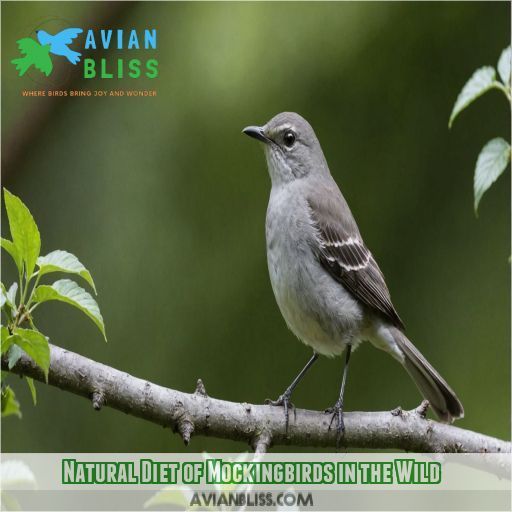
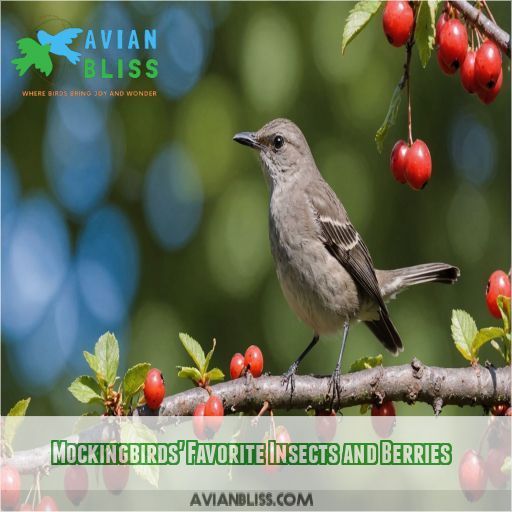
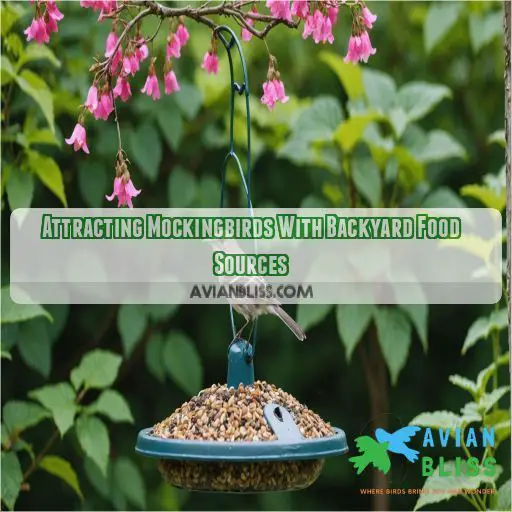

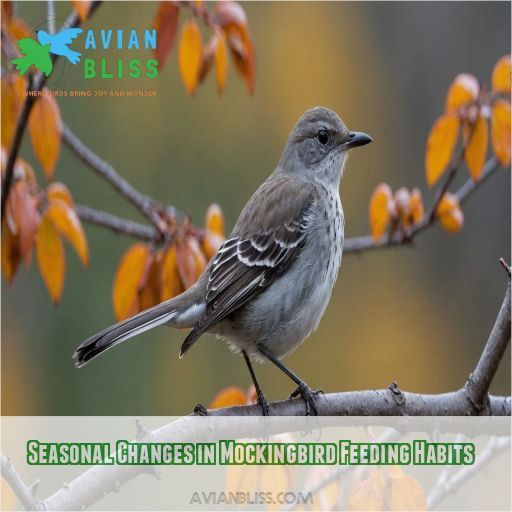
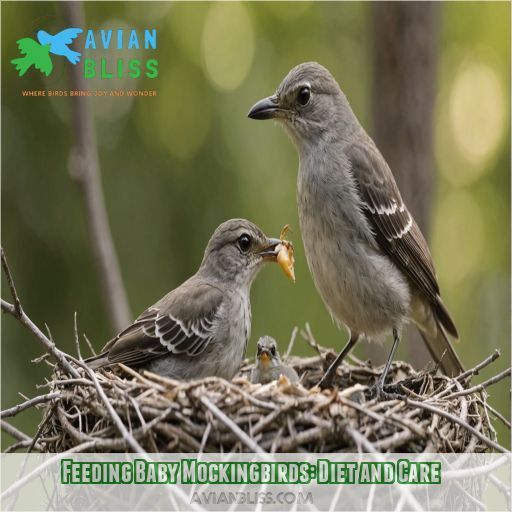

0 Comments